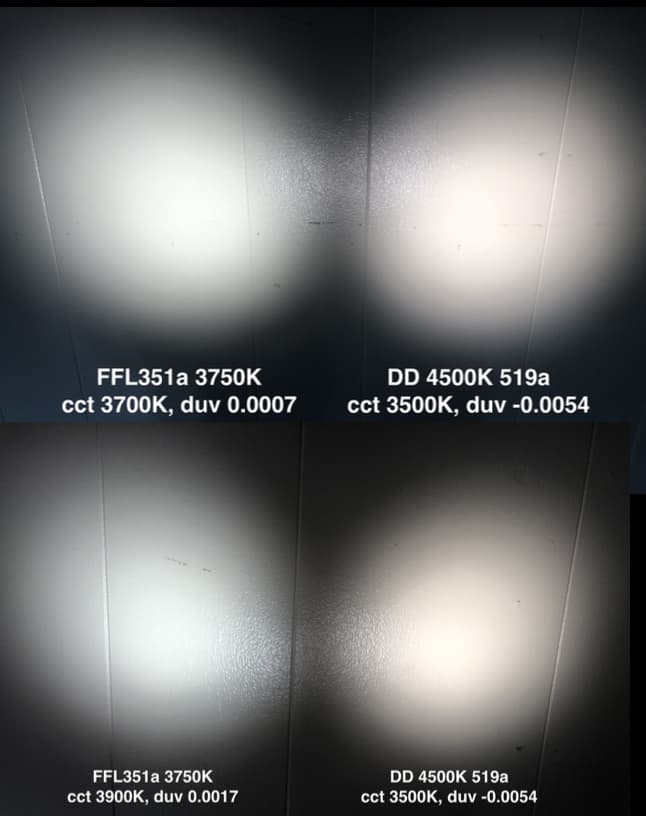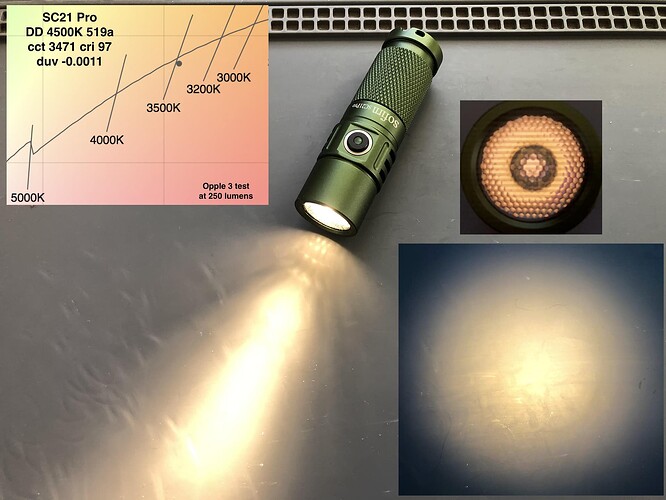2024-05-09
For some time now, Fireflylite has been offering special, customized emitters. Some of these are used in their flashlights. The FFL351A is an emitter in 3535 format without a dome, with high color rendering and - according to reports - a slight red tint (“rosy”).
The LED tested here was provided to me by German flashlight forum (TLF) user @Palladin. Many thanks for this at this point!
Tj --- °C, If --- mA
- Type: flip chip, domeless
- Bin: —
- Color group: 3700 K
- CRI: 95
- Rated voltage: 2.88 V
- Max. Forward current: 3,000 mA
- Max. Peak current: — mA
- Viewing angle: — °
- Thermal resistance: — K/W
- Max. Temperature Tj: max. —°C
Note: There is no datasheet available. Values stated above are taken from the item description from Fireflylite homepage.
The FFL351A as such looks quite inconspicuous. The dark gray substrate is covered by two layers, a white and a yellow layer. The luminous surface appears as a darker square area below the phosphor layer. This design is already familiar from other LEDs such as XP-G4 and XP-L2 and has in the past sometimes led to problematic emission properties in secondary optics.
There are no markings on the surface. An ESD element is not recognizable. Although the silicone is quite robust, the LED should always be handled with care due to the lack of a dome. No damage to corners or edges occurred during the test.
The FFL351A is 3.50 x 3.50 mm in size.
The design of this emitter is very similar to the HM-3535 from LatticePower and the XP-G4 HI, although the ESD protection element is clearly visible on the latter.



The footprint reveals no surprises. It is the standard footprint in 3535 format with a dedicated thermal pad in the middle. The clearly recognizable edge in the contact area indicates the cathode (minus).
By using the standard 3535 footprint (also known as XP as known from older Cree emitters), the LED is fully compatible with available accessories, and the symmetrical package means that centering rings (gaskets) produced on a lathe can also be used. This means swapping existing emitters in lights is relatively easy.

The luminous area is 4.3 mm² in size. Some light shimmers through at the side, which makes it much more difficult to determine the illuminated area. This is quite common for modern LEDs in Flip chip design. The LED chip here is probably 2.0 x 2.0 mm in size and thus corresponds to the design of many other current LEDs.

Within official parameters, as far as known:
- at 3,000 mA (official maximum current): 802 lm @ 3.28 V
- Power at official maximum: 9.83 W
- Efficiency at 3,000 mA: 81.6 lm/W
- Maximum reached at 8.4 A, at this point 1385 lm @ 3.74 V
- Power at maximum 31.5 W
- Efficiency at maximum 44.0 lm/W

The general performance of the FFL351A is good, especially when you consider the smaller footprint and high color rendering. A comparison with the FFL505A in particular shows that the larger illuminated area can also make an enormous difference in terms of efficiency. The Vf is very low and is virtually identical to the SFT-40 3000 K, and the overcurrent capability almost fully exploits the 3535 footprint. With this footprint, the maximum achievable current is around 9-10 A, although this also depends heavily on the Vf.
Direct drive of these LEDs - especially when connected in parallel as a triple - is not recommended. Especially when using batteries with low internal resistance and thus good voltage behavior, the LED current can be too high, which massively reduces the service life.
More than 5 A is not recommended for the FFL351A in terms of efficiency and the low luminous flux gain.

Data for 25 °C Tsp (at 85 °C the luminance values are around 13 % lower).
Despite the lack of a dome, the luminance is not very high. This is primarily due to the low efficiency due to the warm color temperature and high color rendering. The SFT-40 3000 K benefits in particular from better heat dissipation and significantly higher maximum performance. For higher luminance levels, LEDs with a higher color temperature or lower CRI must be used.

The beam is perfect. There are no disturbing color distortions or artifacts in the beam, despite the areas of the LED chip shining through at the sides. It basically looks like a dedomed 519A, only the corona around the spot might be a little bit bigger.
Slight rings are visible in the beam, which are caused by the reflector used and are less clearly visible in real life. All in all, these LEDs are also suitable for all those who value the best possible beam, especially when OP reflectors or diffuse lenses are used.
The light quality is high. As already reported in advance, the duv is clearly negative, the tint is reddish (also called “rosy”). Ra and R9 are very high and are therefore in good company with the FFL505A. As with other warm white LEDs with very high color rendering, the saturation Rg is also very high, a value above 100 indicates oversaturation, which is mainly due to the high red component.
The CCT is almost 4000 K. Due to the strong red tint, the light appears subjectively warmer, nominally this sample tested here can be classified as 4000 K neutral white.
The light looks very nice, although depending on your own perception, red colors may be overemphasized, which can be particularly noticeable in forests. If you value balanced color representation, you should look for LEDs with duv close to 0 or choose a higher color temperature.
- Ra: 96
- R9: 97
- CCT: 3955 K
- duv: -0.0064
The FFL351A is an interesting LED. Almost 4000 K, reddish (“rosy”) tint and very high color rendering, very good beam in optics and good overcurrent capability make it a unique LED at the moment, maybe apart from the dedomed Nichia 519A. If modifications to already soldered LEDs are undesirable and a reddish tint is essential, these LEDs are worth a closer look.
In general, these are good all-rounder LEDs that have no real weaknesses and can be used universally for all types of flashlights with 3535 footprint.
Unfortunately, they are only available in China, there is no important information about the manufacturer and - as with many Chinese LEDs - a data sheet is not available.
Pro
- very high color rendition
- pleasant tint (“rosy”)
- very good beam in reflectors
- good overcurrent possibilities
- standard footprint for maximum compatibility
Neutral
- only available in one specific CCT/CRI
Contra
- only available in China / from chinese sellers
- no datasheet available
- no information about manufacturer available
Thank you for reading the test. ![]()

